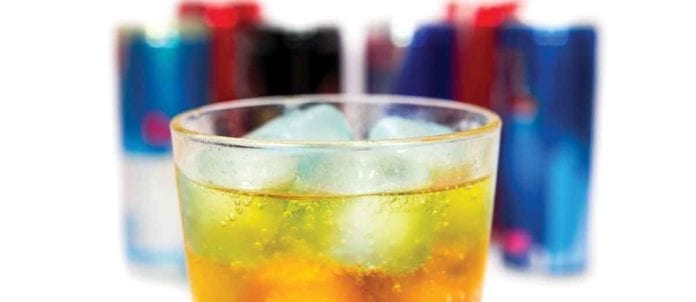It’s not a joke: What’s the difference between an Irish coffee and a Vodka Red Bull (VRB)? People sip an Irish coffee — caffeine, whisky, sugar and cream — slowly, while they slug back several VRBs in quick succession. Adding alcohol to caffeinated energy drinks (CEDs) converts them into highly potent beverages, which can be lucrative. Devon McKenzie, who owns and operates Stark & Perri and two other nightclubs in downtown Waterloo, Ont., says “There’s no substitute for Red Bull,” adding they move about 35 cases a week, most of which is consumed with Jagermeister. And, in fact, they don’t really sell anything but Red Bull when it comes to energy drinks. “It’s the premium brand.”
Its cultural status and sweetness make energy drinks particularly attractive to its primary target audience — young adults between the ages of 15 and 25. “It’s more of a youthful drink. We don’t get any 50-year-olds drinking it,” says Doug Rasberry, president of Ranchman’s Cookhouse in Calgary.
While the consumption of sugary drinks such as pop has declined, a study by the University of Waterloo revealed CED sales rose by 638 per cent between 2001 and 2015. In Quebec, sales of high-alcohol AmEDs (alcohol mixed with an energy drink) grew by about 300 per cent in 2016/2017, accounting for four per cent of beverage alcohol sold at dépanneurs and grocery stores, according to a CBC report.
A 250 ml can of a CED contains between 80 and 100 mg of caffeine, while a 250 ml cup of drip coffee contains about 179 mg of caffeine. However, CEDs also have ingredients such as sugar, L-carnitine, taurine and guarana, which itself contains caffeine. These ingredients — especially when blended with alcohol — mask the effects of the alcohol. As a result, alcohol retailers in Alberta are not permitted to sell energy drinks and Quebec has prohibited the sale of AmEDs with more than seven-per-cent alcohol in corner stores (only the SAQ can sell AmEDs over that percentage). While the LCBO does not sell AmEDs, there is no legislation for selling the drinks in bars. Most often, customers mix the drinks themselves — requesting a can and a shot. The beverages include such combinations as a CED, vodka and sparkling lemon water and a “breakfast” drink of Java Monster Mean Bean, coffee and vodka. Other drinks might combine Bud Light, Jagermeister and a NOS-brand energy drink.
At Ranchman’s, Rasberry says energy drinks are about 20-per-cent less popular than five years ago, where legislation prohibits bars from mixing the drink. “We still sell a reasonable amount,” he says, pointing to Monster Energy and vodka as the most popular choice. Studies examining the potency of such super-charged drinks have noted that consumers of energy drinks mixed with alcohol drink more than consumers who drink only alcohol. Customers tend to stay at a bar longer, due in part to the suppression of signs that indicate to them that they should stop drinking — which has the corollary effect of boosting alcohol sales. McKenzie says the margins are high, with four shots to a can of Red Bull.
Written by Andrew Coppolino


















